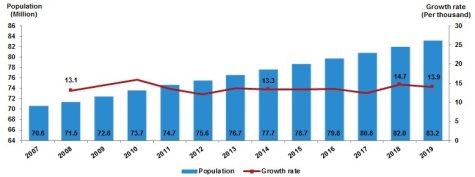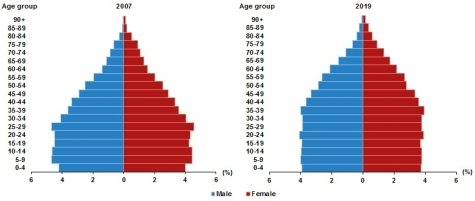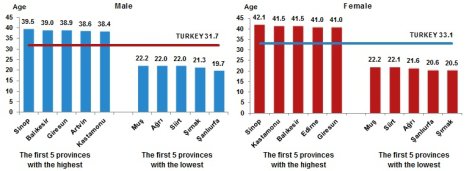* Photo: Anadolu Agency (AA)
Click to read the article in Turkish
The Turkish Statistical Institute (TurkStat) announced the "Results of Address-Based Population Registration System" today (February 4).
Accordingly, the population residing in Turkey has increased by 1 million 115 thousand 115 people when compared to the previous year, reaching 83 million 154 thousand 997 people as of December 31, 2019.
While 50.2 percent (41 million 721 thousand 136 people) of the total population of Turkey were men, 49.8 percent (41 million 433 thousand 861 people) of the total population were women.
Annual population growth rate decreased to 13.9 per thousand in 2019 from 14.7 per thousand in 2018.

* Population and annual population growth rate, 2007-2019
The proportion of the population residing in province and district centers increased to 92.8 percent in 2019 from 92.3 percent in 2018.
According to the results of Address Based Population Registration System (ABPRS), foreign population residing in Turkey increased by 320 thousand 146 people and reached 1 million 531 thousand 180 people. While 50.8 percent of this population were men and 49.2 percent were women.
The TurkStat has shared the following figures:
Population living in province and district centers
The proportion of the population residing in province and district centers increased to 92.8 percent in 2019 from 92.3 percent in 2018. Besides, the proportion of the population living in towns and villages decreased to 7.2 percent from its previous level of 7.7 percent.
Population of İstanbul: Over 15 million
The population residing in İstanbul increased by 451 thousand 543 people compared to the previous year and reached 15 million 519 thousand 267.
İstanbul, constituting 18.66 percent of Turkey's population, was followed by Ankara with 5 million 639 thousand 76 inhabitants, İzmir with 4 million 367 thousand 251 inhabitants, Bursa with 3 million 56 thousand 120 inhabitants and Antalya with 2 million 511 thousand 700 inhabitants.

* The first 5 provinces with the highest population by sex, 2019
The least populated province: Tunceli
Tunceli was the least populated province with 84 thousand 660 people. This province was followed by Bayburt with 84 thousand 843 inhabitants, Ardahan with 97 thousand 319 inhabitants, Kilis with 142 thousand 490 inhabitants and Gümüşhane with 164 thousand 521 inhabitants.

* The first 5 provinces with the lowest population by sex, 2019
Structural change in population pyramid
Population pyramids can be defined as the graphs that show the changes in the age-sex structure of the population. When the population pyramids of Turkey were compared for the years 2007 and 2019, it is seen that there is increase in the elderly population and rise in the median age, due to the decline in the fertility and mortality rates.

* Population pyramid, 2007, 2019
Median age of Turkey's population
The median age is the age of the person in the middle when the ages of the all people in the population are sorted from the new-born baby to the oldest. Median age is also one of the important indicators used in the interpretation of the age structure of the population.
The median age of the population in Turkey increased to 32.4 in 2019 from 32 in 2018. While the median age of males increased from 31.4 to 31.7, the median age of females increased from 32.7 to 33.1.
Şanlıurfa had the lowest median age
When the median age was examined by the provinces, it was seen that Sinop had the highest median age with 40.8.
This province was followed by Balıkesir with 40.2 and Giresun with 39.9. On the other side, Şanlıurfa had the lowest median age with 20.1. This province was followed by Şırnak with 20.9 and Ağrı with 21.8.

* Median age by sex, 2007-2019
Sinop had the highest median age
When the median age was examined by sex and provinces, it was seen that for the male population, Sinop had the highest median age with 39.5 and Şanlıurfa had the lowest median age with 19.7.
For the female population, Sinop had the highest median age with 42.1 and Şırnak had the lowest median age with 20.5.

* The first 5 provinces with the highest and the lowest median age by sex, 2019
Proportion of population in working age group
The proportion of the working age population aged 15-64 increased from 66.5 percent in 2007 to 67.8 percent in 2019.
Accordingly, the proportion of child population aged 0-14 decreased from 26.4 percent to 23.1 percent, proportion of population aged 65 and over increased from 7.1 percent to 9.1 percent.
Total age dependency ratio increased
Total age dependency ratio which indicates the total number of children and elderly people per person in working age increased from 47.4 percent in 2018 to 47.5 percent in 2019.
Child dependency ratio which indicates the total number of children per person in working age decreased from 34.5 percent to 34.1 percent.
Elderly dependency ratio which indicates the number of people aged 65 and over per person in working age increased from 12.9 percent to 13.4 percent. In other words, 100 people in working age were responsible for 34.1 children and 13.4 elders in Turkey for 2019.

* Proportion of population by age groups, 2007, 2019
Number of people per square kilometer
The population density, which is the number of persons per square kilometer, increased by 1 person compared to 2018 and reached 108 in 2019.
İstanbul had the highest population density with 2 thousand 987 persons per square kilometer. This province was followed by Kocaeli with 541 people and İzmir with 364 people. On the other side, Tunceli was the province which had the smallest population density with 11 people per square kilometer. This province was followed by Ardahan and Erzincan with 20 people each.
Population density of Konya, which has the largest surface area, was 57 and population density of Yalova, which has the smallest surface area, was 320.
Explanations by the TurkStat"Populations of localities were calculated by considering the records of Address Based Population Registration System, which is updated by the Ministry of Interior General Directorate of Civil Registration and Nationality, and the institutional population. According to the international definitions, persons who live in institutional places such as military barracks, prisons, nursing homes, university dormitories, etc. are included in the population of localities where the institutions are sited. "In addition, population of provinces, districts, municipalities, villages and quarters are determined according to the records of the National Address Database as of 31 December 2019. "(1) Foreign population covers individuals who are holding a valid residence/work permit at the reference day and individuals who have a valid address declaration at the reference day while holding an identity document equivalent to residence permit such as international protection identity document and the individuals who have already renounced his/her Turkish Republic citizenship and who have a valid address declaration at the reference day. In addition to Syrians under temporary protection, foreigners holding visas or residence permits shorter than 3 months with the purpose of training, tourism, scientific research, etc. are not covered." |
(HA/SD)
* Source: TurkStat





